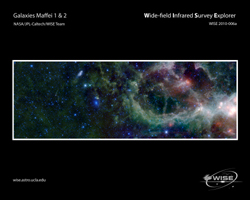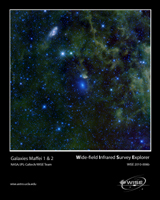 |  |
| Package Imaged A | Package Imaged B |
A mosaic of images from WISE in the constellation of Cassiopeia. This region contains a large star forming nebula within the Milky Way Galaxy, called IC 1805 (sometimes called the Heart Nebula), a portion of which is seen at the right of the image. IC 1805 is over 6 thousand light-years from Earth. Also visible in this image are two nearby galaxies, Maffei 1 and Maffei 2. In visible light these galaxies are hidden by dust in IC 1805 and were unknown until 1968 when Paolo Maffei found them using infrared observations. Both galaxies contain billions of stars and are located some 10 million light-years away (well outside our own Milky Way Galaxy). Maffei 1 is the bluish elliptical object in the center of the image. It is a Lenticular type galaxy, which has a disk-like structure and a central bulge but no spiral structure or appreciable dust content. Maffei 2 (to the upper left of Maffei 1) is a Spiral type galaxy that also has a disk shape, but with a bar-like central bulge and two prominent dusty spiral arms.
The image size is about 1.6 by 4.5 degrees (the full Moon is about 0.5 degrees across by comparison). Since this is an image of invisible infrared light, blue is mapped to the WISE 3.4 & 4.6 micron channels and is dominated by star light. Green represents the WISE 12 micron channel, and red is the 22 micron channel, which are dominated by infrared emission from warm interstellar dust.
The original 62MB (11,795 x 4087) TIFF file can be downloaded here: Maffei1_2.tiff.
NASA's Jet Propulsion Laboratory, Pasadena, Calif., manages the Wide-field Infrared Survey Explorer for NASA's Science Mission Directorate, Washington. The mission's principal investigator, Edward Wright, is at UCLA. The mission was competitively selected under NASA's Explorers Program managed by the Goddard Space Flight Center, Greenbelt, Md. The science instrument was built by the Space Dynamics Laboratory, Logan, Utah, and the spacecraft was built by Ball Aerospace & Technologies Corp., Boulder, Colo. Science operations and data processing take place at the Infrared Processing and Analysis Center at the California Institute of Technology in Pasadena. Caltech manages JPL for NASA.
More information is online at http://www.nasa.gov/wise and http://wise.astro.ucla.edu.

